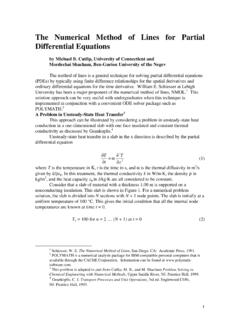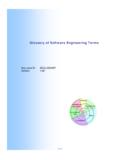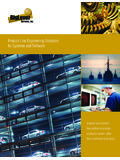Transcription of THE USE OF MATHEMATICAL SOFTWARE …
1 Page 1 THE USE OF MATHEMATICAL SOFTWARE PACKAGES IN CHEMICAL engineering INTRODUCTION This collection of problems was developed for Session 12 at the ASEE Chemical Engi-neering Summer School held in Snowbird, Utah on August 13, 1997. These problemsare intended to utilize the basic numerical methods in problems which are appropri-ate to a variety of chemical engineering subject areas. The problems are titled accord-ing to the chemical engineering principles which are used, the problems are arrangedaccording to the numerical methods which are applied as summarized in Table problem has been solved by each of the MATHEMATICAL packages: Excel,Maple, Mathcad*, MATLAB, Mathematica*, and Polymath*. The CACHE Corpora-tion has made available this problem set as well as the individual package writeups* This material was originally distributed at the Chemical engineering Summer School at Snow-bird, Utah on August 13, 1997 in Session 12 entitled The Use of MATHEMATICAL SOFTWARE in ChemicalEngineering.
2 The Ch. E. Summer School was sponsored by the Chemical engineering Division of theAmerican Society for engineering Education. This material is copyrighted by the authors, and permis-sion must be obtained for duplication unless for educational use within departments of chemical engi-neering. MATHEMATICAL SOFTWARE - Session 12 * Michael B. Cutlip, Department of Chemical engineering , Box U-222, University of Connecticut, Storrs, CT 06269-3222 J. Hwalek, Department of Chemical engineering , University of Maine, Orono, ME 04469 Eric Nuttall, Department of Chemical and Nuclear engineering , University of New Mexico, Albuquerque, NM 87134-1341 Shacham, Department of Chemical engineering , Ben-Gurion Uni-versity of the Negev, Beer Sheva, Israel 84105 Contributors:Joseph Brule, John Widmann, Tae Han, and Bruce Finlayson, Department of Chemical engineering , University of Washington, Seattle, WA 98195-1750 M.
3 Rosen, EMR Technology Group, 13022 Musket Ct., St. Louis, MO 63146 Taylor, Department of Chemical engineering , Clarkson University, Pots-dam, NY 13699-5705 A COLLECTION OF REPRESENTATIVE PROBLEMS IN CHEMICALENGINEERING FOR SOLUTION BY NUMERICAL METHODS Page 2 MATHEMATICAL SOFTWARE PACKAGES IN CHEMICAL engineering and problem solutions at The materials are also available via anon-ymous FTP from in directory /pub/ASEE. The problem set and details of the vari-ous solutions are given in separate documents as Adobe PDF files. Additionally, the problem sets areavailable for the various MATHEMATICAL package as working files which can be downloaded for execu-tion with the MATHEMATICAL SOFTWARE . This method of presentation should indicate the convenienceand strengths/weaknesses of each of the MATHEMATICAL SOFTWARE packages and provides working selection of problems has been coordinated by M.
4 B. Cutlip who served as the session chair-man. The particular co-author who has considerable experience with a particular MATHEMATICAL pack-age is responsible for the solution with that package*.Excel** - Edward M. Rosen, EMR Technology GroupMaple** - Ross Taylor, Clarkson UniversityMathematica** - H. Eric Nuttall, University of New MexicoMathcad** - John J. Hwalek, University of MaineMATLAB** - Joseph Brule, John Widmann, Tae Han, and Bruce Finlayson, Department ofChemical engineering , University of WashingtonPOLYMATH** - Michael B. Cutlip, University of Connecticut and Mordechai Shacham, Ben-Gurion University of the NegevThis selection of problems should help chemical engineering faculty evaluate which mathemati-cal problem solving package they wish to use in their courses and should provide some typical prob-lems in various courses which can be utilized.
5 * The CACHE Corporation is non-profit educational corporation supported by most chemical engineering departmentsand many chemical corporation. CACHE stands for computer aides for chemical engineering . CACHE can be contacted at Box 7939, Austin, TX 78713-7939, Phone: (512)471-4933 Fax: (512)295-4498, E-mail: Internet: ** Excel is a trademark of Microsoft Corporation ( ), Maple is a trademark of Waterloo Maple,Inc. ( ), Mathematica is a trademark of Wolfram Research, Inc. ( ), Mathcad is atrademark of Mathsoft, Inc. ( ), MATLAB is a trademark of The Math Works, Inc. ( ), and POLYMATH is copyrighted by M. B. Cutlip and M. Shacham ( ). Problem Page 3 * Problem originally suggested by H. S. Fogler of the University of Michigan** Problem preparation assistance by N. Brauner of Tel-Aviv University These problem are taken in part from a new book entitled Problem Solving in Chemical engineering with NumericalMethods by Michael B.
6 Cutlip and Mordechai Shacham to be published by Prentice-Hall in 1999. Table 1 Selection of Problems Solutions Illustrating MATHEMATICAL SOFTWARE COURSEPROBLEM TITLEMATHEMATICAL MODELPROBLEM Introduction to Ch. Volume and Compressibility Factor from Van Der Waals EquationSingle Nonlinear Equation1 Introduction to Ch. State Material Balances on a Sep-aration Train*Simultaneous Lin-ear Equations2 MATHEMATICAL MethodsVapor Pressure Data Representation by Polynomials and EquationsPolynomial Fit-ting, Linear and Nonlinear Regres-sion3 ThermodynamicsReaction Equilibrium for Multiple Gas Phase Reactions*Simultaneous Nonlinear Equa-tions4 Fluid DynamicsTerminal Velocity of Falling ParticlesSingle Nonlinear Equation5 Heat TransferUnsteady State Heat Exchange in a Series of Agitated Tanks*Simultaneous ODE s with known initial TransferDiffusion with Chemical Reaction in a One Dimensional SlabSimultaneous ODE s with split boundary ProcessesBinary Batch Distillation**Simultaneous Dif-ferential and Non-linear Algebraic Equations8 Reaction EngineeringReversible, Exothermic.
7 Gas Phase Reac-tion in a Catalytic Reactor*Simultaneous ODE s and Alge-braic Equations9 Process Dynamics and ControlDynamics of a Heated Tank with PI Tem-perature Control**Simultaneous Stiff ODE s10 Selection Page 4 MATHEMATICAL SOFTWARE PACKAGES IN CHEMICAL engineering 1. M OLAR V OLUME AND C OMPRESSIBILITY F ACTOR FROM V AN D ER W AALS E Numerical Methods Solution of a single nonlinear algebraic equation. Concepts Utilized Use of the van der Waals equation of state to calculate molar volume and compressibility factor for agas. Course Useage Introduction to Chemical engineering , Thermodynamics. Problem Statement The ideal gas law can represent the pressure-volume-temperature (PVT) relationship of gases only atlow (near atmospheric) pressures. For higher pressures more complex equations of state should beused. The calculation of the molar volume and the compressibility factor using complex equations ofstate typically requires a numerical solution when the pressure and temperature are van der Waals equation of state is given by (1) where (2) and (3) The variables are defined by P = pressure in atm V = molar volume in liters/g-mol T = temperature in K R = gas constant ( R = atm.)
8 Liter/g-mol . K) T c = critical temperature ( K for ammonia) P c = critical pressure ( atm for ammonia)PaV2-------+ Vb ()RT=a2764------R2Tc2Pc-------------- =bRTc8Pc-----------= Problem 1. MOLAR VOLUME AND COMPRESSIBILITY FACTOR FROM VAN DER WAALS EQUATIONPage 5 Reduced pressure is defined as (4) and the compressibility factor is given by (5)PrPPc------=ZPVRT---------=(a)Calcula te the molar volume and compressibility factor for gaseous ammonia at a pressureP = 56 atm and a temperature T = 450 K using the van der Waals equation of state. (b)Repeat the calculations for the following reduced pressures: Pr = 1, 2, 4, 10, and 20. (c)How does the compressibility factor vary as a function of Page 6 MATHEMATICAL SOFTWARE PACKAGES IN CHEMICAL engineering 2. S TEADY S TATE M ATERIAL B ALANCES ON A S EPARATION T Numerical Methods Solution of simultaneous linear equations.
9 Concepts Utilized Material balances on a steady state process with no recycle. Course Useage Introduction to Chemical engineering . Problem Statement Xylene, styrene, toluene and benzene are to be separated with the array of distillation columns that isshown below where F, D, B, D1, B1, D2 and B2 are the molar flow rates in Xylene25% Styrene40% Toluene20% BenzeneF=70 mol/minDBD1B1D2B2{{{{ 7% Xylene 4% Styrene54% Toluene35% Benzene18% Xylene24% Styrene42% Toluene16% Benzene15% Xylene10% Styrene54% Toluene21% Benzene24% Xylene65% Styrene10% Toluene 1% Benzene#1#2#3 Figure 1 Separation Train Problem 2. STEADY STATE MATERIAL BALANCES ON A SEPARATION TRAINPage 7 Material balances on individual components on the overall separation train yield the equation set (6) Overall balances and individual component balances on column #2 can be used to determine themolar flow rate and mole fractions from the equation of stream D from (7) where X Dx = mole fraction of Xylene, X Ds = mole fraction of Styrene, X Dt = mole fraction of Toluene,and X Db = mole fraction of , overall balances and individual component balances on column #3 can be used todetermine the molar flow rate and mole fractions of stream B from the equation set (8)Xylene: 70 =+++Styrene: 70 =+++Toluene: 70 =+++Benzene: 70 =+++Molar Flow Rates: D = D1 + B1 Xylene:XDxD = + :XDsD = + :XDtD = + : XDbD = + Flow Rates: B = D2 + B2 Xylene:XBxB = +.}}}}
10 XBsB = + :XBtB = + : XBbB = + (a)Calculate the molar flow rates of streams D1, D2, B1 and B2. (b)Determine the molar flow rates and compositions of streams B and D. Page 8 MATHEMATICAL SOFTWARE PACKAGES IN CHEMICAL engineering 3. V APOR P RESSURE D ATA R EPRESENTATION BY P OLYNOMIALS AND E Numerical Methods Regression of polynomials of various degrees. Linear regression of MATHEMATICAL models with variabletransformations. Nonlinear regression. Concepts Utilized Use of polynomials, a modified Clausius-Clapeyron equation, and the Antoine equation to model vaporpressure versus temperature data Course Useage MATHEMATICAL Methods, Thermodynamics. Problem Statement Table (2) presents data of vapor pressure versus temperature for benzene.







